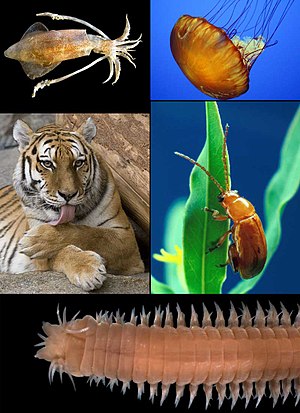| Eumetazoa | |
|---|---|
 | |
| Scientific classification | |
| Domain: | Eukaryota |
| Kingdom: | Animalia |
| Subkingdom: | Eumetazoa Buetschli, 1910 |
| Phyla | |
| |
| Synonyms | |
Eumetazoa (from Ancient Greek εὖ (eû) 'well', μετά (metá) 'after', and ζῷον (zôion) 'animal'), also known as diploblasts, Epitheliozoa or Histozoa, are a proposed basal animal clade as a sister group of Porifera (sponges).[5][6][7][8][9] The basal eumetazoan clades are the Ctenophora and the ParaHoxozoa. Placozoa is now also seen as a eumetazoan in the ParaHoxozoa. The competing hypothesis is the Myriazoa clade.[10]
Several other extinct or obscure life forms, such as Iotuba and Thectardis, appear to have emerged in the group.[11] Characteristics of eumetazoans include true tissues organized into germ layers, the presence of neurons and muscles, and an embryo that goes through a gastrula stage.
Some phylogenists once speculated the sponges and eumetazoans evolved separately from different single-celled organisms, which would have meant that the animal kingdom does not form a clade (a complete grouping of all organisms descended from a common ancestor). However, genetic studies and some morphological characteristics, like the common presence of choanocytes, now unanimously support a common origin.[12]
Traditionally, eumetazoans are a major group of animals in the Five Kingdoms classification of Lynn Margulis and K. V. Schwartz, comprising the Radiata and Bilateria – all animals except the sponges.[13] When treated as a formal taxon Eumetazoa is typically ranked as a subkingdom. The name Metazoa has also been used to refer to this group, but more often refers to the Animalia as a whole. Many classification schemes do not include a subkingdom Eumetazoa.